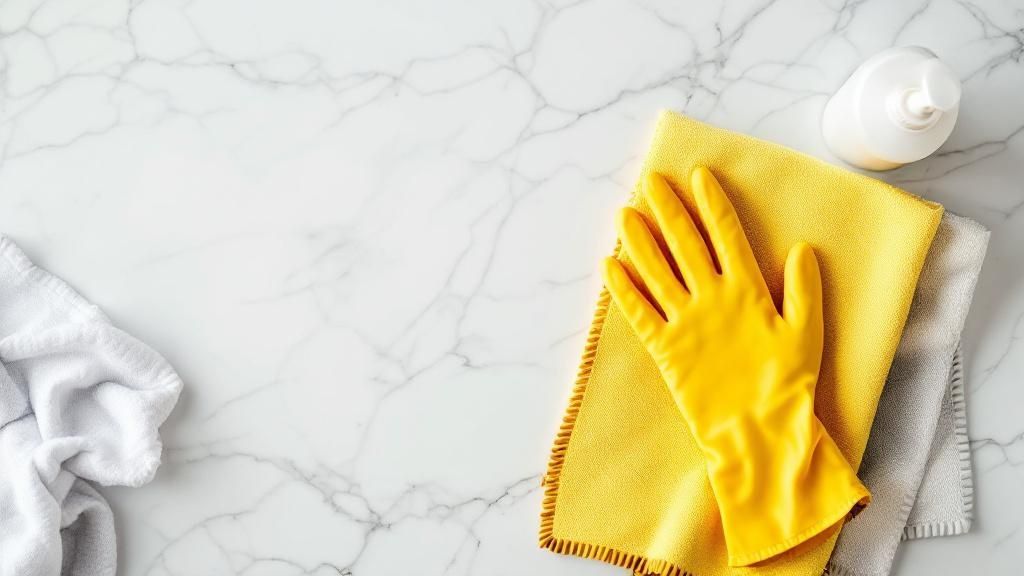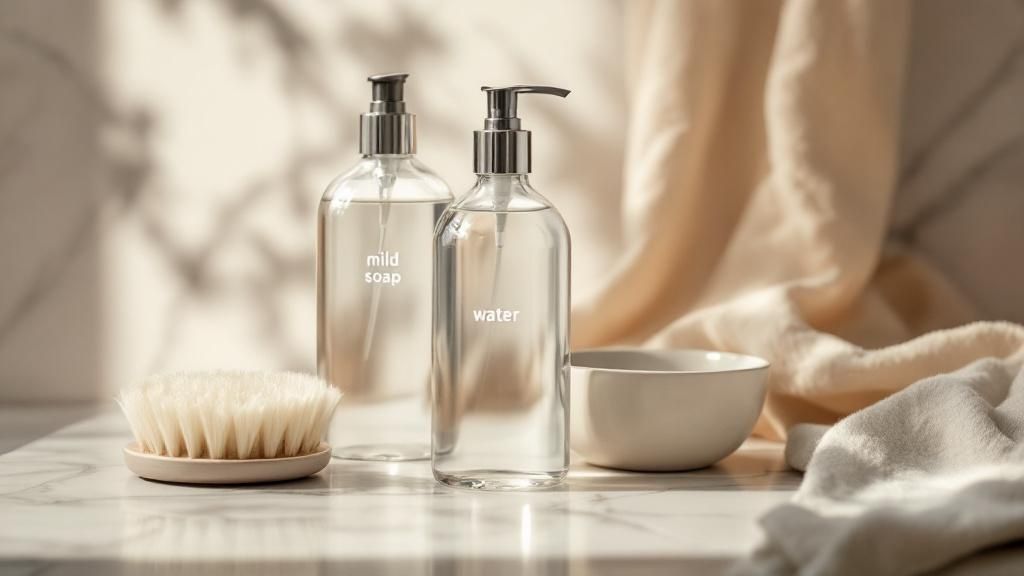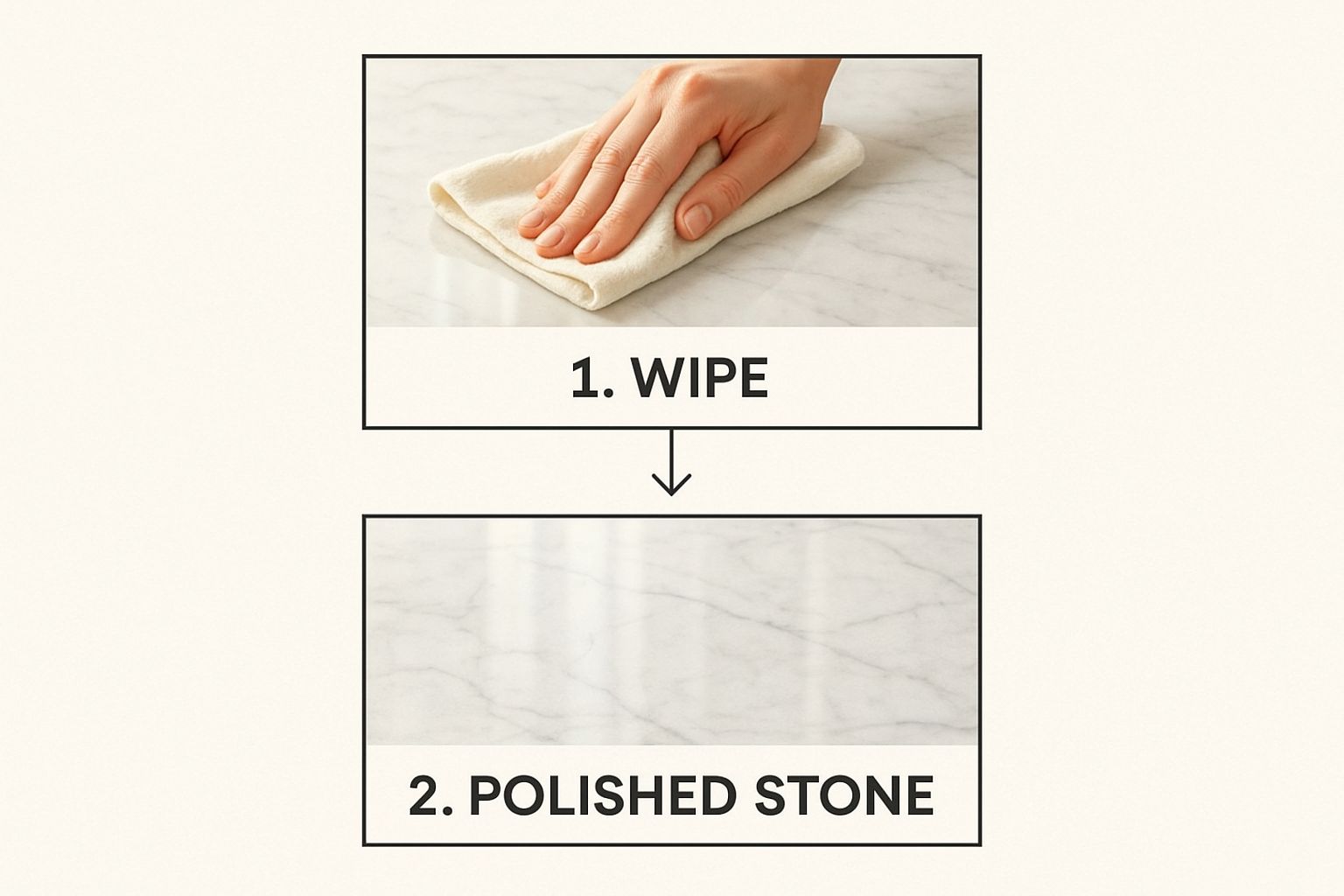Why Your Marble Deserves Special Treatment
Many people think of marble as just another stone, but it’s so much more than that. I like to think of it as a living material because of how it reacts to its environment. Everything from your morning coffee to the cleaner you use can affect it, thanks to its porous nature. This isn't just about keeping it pretty; it's about protecting what is often a significant investment. With marble becoming a staple in modern homes—part of a global market expected to hit $92.23 billion by 2030—knowing how to care for it is crucial. You can explore the full marble market trends to see just how popular this timeless stone is.
The main reason marble requires such specific care comes down to its chemical makeup. It's primarily composed of calcium carbonate, which has a serious aversion to acids. This means everyday things like a splash of lemon juice, a bit of vinegar, or even many popular all-purpose cleaners can cause etching. Etching is essentially a chemical burn that dulls the surface, leaving a mark that looks like a water spot you can never quite wipe away.
Polished vs. Honed: A Tale of Two Finishes
The finish on your marble also plays a big role in its daily care. A polished finish gives you that classic, glossy look that beautifully shows off the stone's color and veining. However, that mirror-like surface is also quick to show scratches and etches. On the other hand, a honed finish offers a more satin-smooth, matte look. It’s better at hiding minor scratches, but its surface is more porous, making it more susceptible to stains if it isn't sealed correctly. Knowing your finish helps you figure out how to clean your marble without causing damage.
It's important to spot the early warning signs of improper cleaning. If your marble is losing its shine, developing dull spots that won't go away, or feels chalky to the touch, your cleaning routine is likely doing more harm than good. This usually happens when using cleaners with the wrong pH level. For those who own unique marble pieces, like a vintage game board or decorative statues, take a look at our guide on caring for special marble finds to keep them in pristine condition for years to come.
Building Your Marble Care Toolkit

When it comes to caring for marble, you can forget about the all-purpose cleaners under your sink. Marble requires a more thoughtful approach, and that starts with having the right tools on hand. The most critical item in your arsenal is a pH-neutral cleaner. Because marble is a calcium carbonate-based stone, anything too acidic (like vinegar or lemon juice) or too alkaline (like bleach) will literally eat away at its surface, causing dull spots and permanent damage known as etching.
Just as important as the cleaner is what you use to apply it. I always reach for high-quality microfiber cloths. They are exceptionally soft, so they won't scratch a polished finish, but their unique structure is amazing at trapping dust and lifting grime with just a little water. You get a thorough clean without harsh scrubbing, which is exactly what your delicate marble surfaces need.
Your Everyday Arsenal
Putting together your marble care kit is simple. These are the essentials I use for daily maintenance on everything from my marble game board to my kitchen countertops. They keep my marble looking pristine without any fuss. And if you're passionate about incorporating more beautiful stone into your home, you might love our guide to unique home decor gifts to elevate any space.
- A pH-Neutral Spray Cleaner: This is your go-to for quick, safe wipe-downs and dealing with minor spills.
- Several Microfiber Cloths: I suggest keeping at least three on hand: one for dry dusting, another for wet cleaning, and a third for buffing the surface dry to a streak-free shine.
- A Soft-Bristle Brush: This is perfect for getting into the grout lines on marble tile floors or gently cleaning textured marble pieces without causing scratches.
- Distilled Water: If you live in an area with hard water, using distilled water in your cleaning spray is a game-changer. It prevents the mineral deposits that cause those frustrating streaks and cloudy films.
To make it easier to know what's safe, I've put together a quick reference table. It breaks down which products are friends to your marble and which are definite foes.
| Product Type | Safe Options | Avoid Completely | Why It Matters |
|---|---|---|---|
| Daily Cleaner | pH-neutral stone cleaner, a drop of gentle dish soap in warm water | Vinegar, lemon juice, all-purpose cleaners, window cleaner | Acidic and alkaline cleaners cause etching, a chemical reaction that dulls and damages the marble's surface permanently. |
| Stain Remover | Stone-specific poultice, a paste of baking soda and water (for oil stains) | Bleach, hydrogen peroxide (on dark marble), abrasive powders | Harsh chemicals can discolor the stone or strip its sealant, leaving it vulnerable to more stains and damage. |
| Scrubbing Tool | Soft microfiber cloth, non-abrasive sponge, soft-bristle brush | Steel wool, scouring pads, stiff-bristled brushes | Abrasive tools will scratch and dull the polished finish of your marble, ruining its beautiful luster. |
| Water | Distilled water, filtered water | Hard tap water (if possible) | Hard water contains minerals like calcium and magnesium that can leave behind a cloudy film and water spots on the surface. |
Ultimately, choosing the right products is the most important step in preserving your marble's beauty. Sticking to safe, gentle options ensures your investment remains stunning for years to come.
Effortless Daily Routines That Prevent Problems

The best way to keep your marble looking gorgeous isn't through intense weekend scrubbing sessions. The real secret lies in simple, daily habits that stop problems before they even start. Think of it as a five-minute daily investment that saves you from hours of restoration work later. This proactive approach is key for keeping any marble surface—from a busy kitchen island to a treasured chess set—looking as good as the day you got it.
This mindset is especially important given how reactive marble is. Spills are a fact of life, but not every drop spells disaster. Your game plan should be to act fast on acidic spills. A bit of wine, a splash of lemon juice, or some tomato sauce can etch the surface in just a few minutes. Wiping these up immediately with a damp microfiber cloth is your first line of defense. A simple water spill, on the other hand, can wait a moment, just as long as you dry it completely to avoid leaving water spots.
Your Five-Minute Marble Maintenance Plan
Making marble care a part of your daily life doesn't have to feel like a chore. I've found that attaching it to habits I already have makes it almost automatic. For instance, right after I finish the breakfast dishes, I give my marble countertops a quick wipe. This simple addition makes learning how to clean marble feel less like a project and more like a natural part of tidying up.
Here’s a practical approach that has worked wonders for me:
- Morning Wipe-Down: Before you do anything else, grab a dry microfiber cloth and dust off any crumbs or debris from your counters or dining table. This simple step prevents tiny particles from being dragged across the surface, which can lead to micro-scratches over time.
- Post-Meal & End-of-Day Spray: After you've used the surface, give it a quick spritz with a pH-neutral cleaner. Wipe it down with a damp microfiber cloth, and then follow up with a dry one to buff away any streaks and lingering moisture. This is particularly important in bathrooms where soap scum and hairspray can build up.
- Tackle Spills Instantly: Keep your spray bottle and a few clean cloths within easy reach. The second a spill happens, blot it—don't wipe. Blotting lifts the liquid up instead of spreading it around. Once you've blotted the worst of it, clean the spot as you normally would.
This consistent, gentle care is the single most effective way to protect your marble investment. It ensures your surfaces stay pristine and prevents minor accidents from turning into permanent damage.
Conquering Stains Without Causing Damage
Even with the most diligent daily care, stubborn stains on marble are almost inevitable. The secret isn't just cleaning, but reacting with the right method for the specific type of stain. It’s a bit like being a first responder for your stonework; you wouldn’t treat a red wine spill the same way you’d handle a greasy fingerprint. Understanding what caused the stain and how it interacts with the porous marble is half the battle. This is less about scrubbing and more about smart, targeted restoration.
For any fresh spill, the immediate protocol is always to blot gently, as shown in the infographic below.

This simple motion is crucial because it lifts the liquid off the surface. Wiping, on the other hand, just spreads the problem and can push the staining agent deeper into the marble’s tiny pores, making your job much harder.
Identifying and Treating Common Stains
Different culprits call for different cleaning strategies. Let's walk through the most common household stains you'll encounter on your marble surfaces, whether it's a countertop, a decorative game board, or a set of coasters.
- Organic Stains (Coffee, Tea, Wine, Food): These are the everyday offenders. If you catch a spill as it happens, blot it up right away. For a stain that has already set, you can try working on the area with a pH-neutral cleaner. Be cautious of common internet advice to use hydrogen peroxide; while it might work, it can also lighten dark-colored marble, leaving you with a new problem.
- Oil-Based Stains (Grease, Cooking Oil, Cosmetics): These types of stains tend to darken the marble. Your most effective tool here is a poultice, which is a paste-like cleaning agent designed to draw the stain out from within the stone. You can make a simple poultice by mixing baking soda and water into a thick paste. Apply it directly to the stain, cover it with plastic wrap, and let it do its magic for about 24 hours before you gently remove it.
- Hard Water Spots & Soap Scum: These are mineral deposits left behind from evaporated water or bathroom products. For minor cases, a good wipe-down with a pH-neutral cleaner and a microfiber cloth should suffice. For more stubborn buildup, you may need a specialized cleaner. The market for marble descaling agents was valued at around USD 35.9 million in 2024, which shows just how many people are dealing with this specific issue. Whatever you do, never reach for vinegar. Its high acidity will cause permanent etching on the stone's surface.
Restoring That Showroom Shine Safely
There comes a time when your marble needs more than just a quick wipe-down; it’s calling for a genuine revival. This is where we shift from routine cleaning to the art of polishing. While regular cleaning handles the daily dust and grime, polishing is what brings back that lost luster and silky-smooth feel, especially if the surface has grown dull from minor wear and tear.
It's helpful to know when your marble has crossed this line. If you're noticing a general dullness, faint scratches, or light etching that a simple cleaning won't touch, it’s probably time to think about polishing. This is a common story for high-traffic surfaces like kitchen counters or even a cherished marble chess set that sees a lot of action.
DIY Polishing vs. Calling the Pros
For minor dullness, you can often bring back some of that original shine yourself. You’ll need a marble-specific polishing powder or compound, which is specially formulated to create a brilliant finish without causing microscopic scratches. It's crucial to remember these are not the same as standard abrasive cleaners, which will permanently damage the stone. Just follow the product’s instructions—it usually involves making a paste and buffing it into the surface with a soft cloth.
However, for deeper etches, noticeable scratches, or widespread dullness, a professional touch is usually the best way to go. The demand for these services speaks for itself; the professional marble polishing market was valued at about $2.5 billion in 2024 and is expected to grow. You can review the full research on marble service market growth to see just how many people trust experts for significant restorations.
Knowing whether to tackle a job yourself or hire a professional can save you a lot of guesswork, time, and even money. To help you make the right call, here’s a straightforward comparison of what to expect from each approach.
DIY vs. Professional Marble Restoration Services
Comparison of costs, results, and appropriate scenarios for DIY versus professional marble care
| Service Type | Cost Range | Expected Results | Best For | Time Required |
|---|---|---|---|---|
| DIY Polishing | $20 – $60 | Moderate shine restoration, improved smoothness. | Minor dullness, light water spots, and very faint etches on small areas. | 1-3 hours |
| Professional Polishing | $4 – $10 per sq. ft. | Showroom-quality, uniform gloss, and removal of most imperfections. | Deep etches, significant scratches, widespread dullness, and stain removal. | 4-8 hours+ |
Ultimately, a DIY approach is fantastic for light maintenance and bringing back a bit of sparkle. But for that deep, flawless, "like-new" finish, especially on larger or heavily-used surfaces, investing in a professional service is almost always worth it.
Protecting Your Investment for the Long Haul
When it comes to keeping marble beautiful, the best approach isn't about frantically scrubbing stains after they appear—it's about smart prevention that stops them from happening in the first place. Going beyond a simple daily wipe-down, long-term protection is all about creating a defense system that works for your home and lifestyle. This means thinking ahead about sealing, seasonal care, and daily habits that will preserve your stone's natural elegance for years to come.
A high-quality sealant is your marble's first line of defense. You might have heard that you should seal your marble every year, but the reality is a bit more personal. A marble countertop in a busy kitchen that sees daily use will need more attention than a decorative fireplace surround that's rarely touched. A great way to check is with a simple water test every six months. Just sprinkle a few drops of water on the surface and wait for about 15 minutes. If the water is still beaded up, your sealant is doing its job. If the water has soaked in and left a dark spot, it's time to reseal.
Smart Habits for Real-World Protection
A few small changes to your daily routine can prevent the most common marble mishaps before they even have a chance to occur. These aren't just cleaning tips; they are protective habits that easily fit into everyday life.
- Coasters and Trivets Are Non-Negotiable: Think of coasters, trivets, and placemats as essential accessories for your marble. They create a crucial physical barrier against heat rings from hot pans, condensation from a cold glass, and acidic spills from things like wine or salad dressing.
- Use Cutting Boards Religiously: This one is simple but vital: never chop anything directly on a marble surface. Even a minor knife scratch can compromise the sealant, creating a weak point that’s vulnerable to stains and further damage.
- Be Mindful of Abrasives: Anything that sits on your marble for an extended period—a fruit bowl, a vase, or even a heavy chess set—can cause tiny scratches over time. Placing soft felt pads underneath these items is a simple fix. If you're looking for decor that's both stylish and safe for your surfaces, our guide on 8 marble home accessories to elevate your space in 2025 offers some wonderful inspiration. This small step prevents the cumulative scratching that can slowly dull your marble's beautiful finish.
By making these proactive strategies part of your routine, you move from constantly reacting to problems to actively preserving your marble's beauty for the long haul.

